Nursing Practice: Reflective Scenarios & Application of Ethical Models
VerifiedAdded on 2022/08/12
|14
|2603
|25
Essay
AI Summary
This essay presents a reflective analysis of various scenarios encountered in nursing practice, utilizing established reflective models such as John's model, Gibbs' reflective cycle, and Driscoll's reflective cycle. The scenarios cover critical aspects of nursing ethics, including patient autonomy, human rights, informed consent, end-of-life care, and negligence. Each scenario is examined through the lens of these models to facilitate a deeper understanding of the ethical implications and to inform future practice. The reflection emphasizes the importance of respecting patient decisions, ensuring equal and fair treatment, obtaining informed consent, providing dignified end-of-life care, and addressing negligence effectively. The essay concludes that reflective practice enhances the nurse's ability to make ethical decisions and improve patient outcomes, highlighting the continuous learning and development inherent in the nursing profession. The appendices reference the source material that inspired the scenarios, acknowledging the contribution of external resources to the reflective process. This resource is available on Desklib, a platform offering study tools for students.
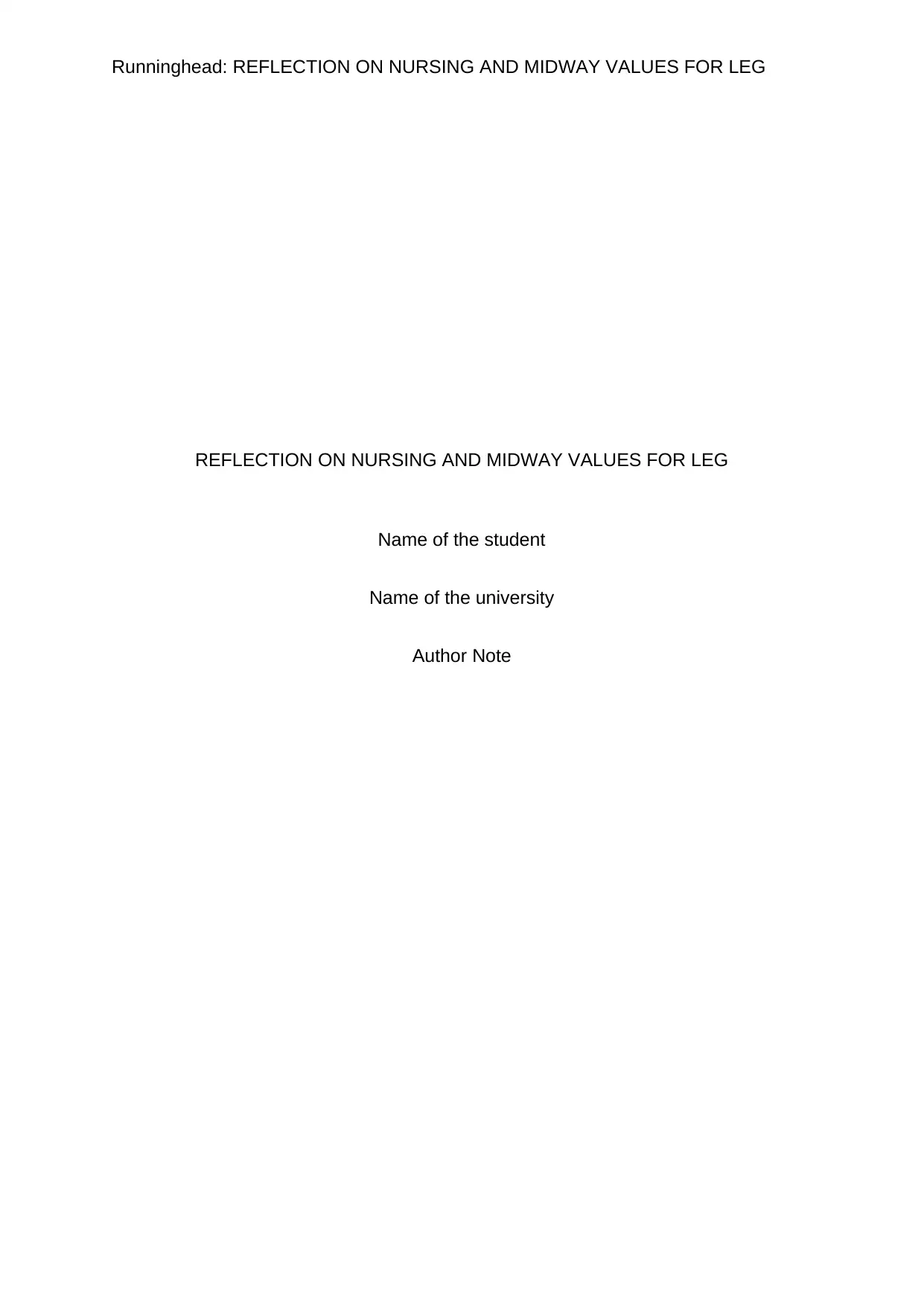
Runninghead: REFLECTION ON NURSING AND MIDWAY VALUES FOR LEG
REFLECTION ON NURSING AND MIDWAY VALUES FOR LEG
Name of the student
Name of the university
Author Note
REFLECTION ON NURSING AND MIDWAY VALUES FOR LEG
Name of the student
Name of the university
Author Note
Paraphrase This Document
Need a fresh take? Get an instant paraphrase of this document with our AI Paraphraser
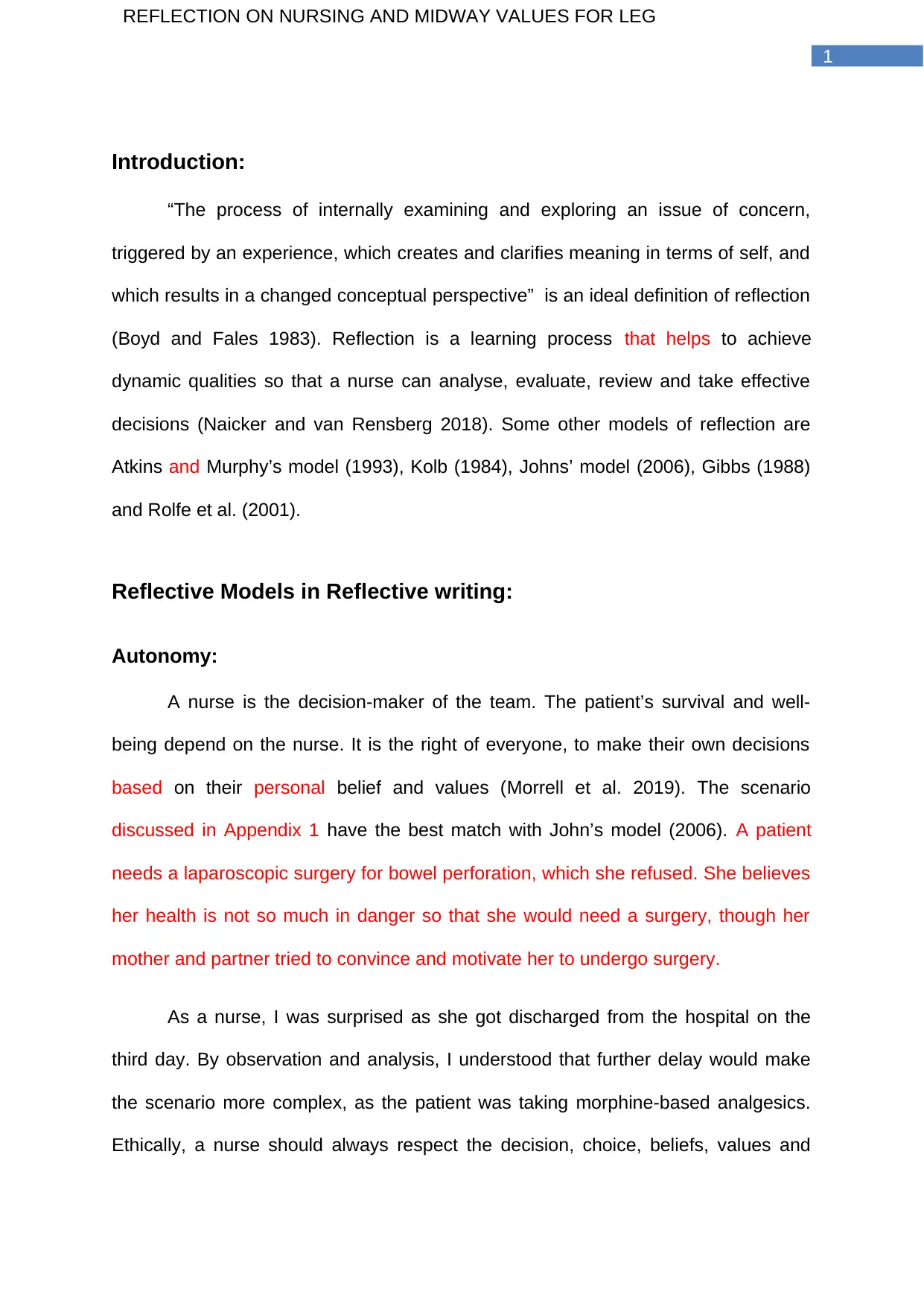
1
REFLECTION ON NURSING AND MIDWAY VALUES FOR LEG
Introduction:
“The process of internally examining and exploring an issue of concern,
triggered by an experience, which creates and clarifies meaning in terms of self, and
which results in a changed conceptual perspective” is an ideal definition of reflection
(Boyd and Fales 1983). Reflection is a learning process that helps to achieve
dynamic qualities so that a nurse can analyse, evaluate, review and take effective
decisions (Naicker and van Rensberg 2018). Some other models of reflection are
Atkins and Murphy’s model (1993), Kolb (1984), Johns’ model (2006), Gibbs (1988)
and Rolfe et al. (2001).
Reflective Models in Reflective writing:
Autonomy:
A nurse is the decision-maker of the team. The patient’s survival and well-
being depend on the nurse. It is the right of everyone, to make their own decisions
based on their personal belief and values (Morrell et al. 2019). The scenario
discussed in Appendix 1 have the best match with John’s model (2006). A patient
needs a laparoscopic surgery for bowel perforation, which she refused. She believes
her health is not so much in danger so that she would need a surgery, though her
mother and partner tried to convince and motivate her to undergo surgery.
As a nurse, I was surprised as she got discharged from the hospital on the
third day. By observation and analysis, I understood that further delay would make
the scenario more complex, as the patient was taking morphine-based analgesics.
Ethically, a nurse should always respect the decision, choice, beliefs, values and
REFLECTION ON NURSING AND MIDWAY VALUES FOR LEG
Introduction:
“The process of internally examining and exploring an issue of concern,
triggered by an experience, which creates and clarifies meaning in terms of self, and
which results in a changed conceptual perspective” is an ideal definition of reflection
(Boyd and Fales 1983). Reflection is a learning process that helps to achieve
dynamic qualities so that a nurse can analyse, evaluate, review and take effective
decisions (Naicker and van Rensberg 2018). Some other models of reflection are
Atkins and Murphy’s model (1993), Kolb (1984), Johns’ model (2006), Gibbs (1988)
and Rolfe et al. (2001).
Reflective Models in Reflective writing:
Autonomy:
A nurse is the decision-maker of the team. The patient’s survival and well-
being depend on the nurse. It is the right of everyone, to make their own decisions
based on their personal belief and values (Morrell et al. 2019). The scenario
discussed in Appendix 1 have the best match with John’s model (2006). A patient
needs a laparoscopic surgery for bowel perforation, which she refused. She believes
her health is not so much in danger so that she would need a surgery, though her
mother and partner tried to convince and motivate her to undergo surgery.
As a nurse, I was surprised as she got discharged from the hospital on the
third day. By observation and analysis, I understood that further delay would make
the scenario more complex, as the patient was taking morphine-based analgesics.
Ethically, a nurse should always respect the decision, choice, beliefs, values and
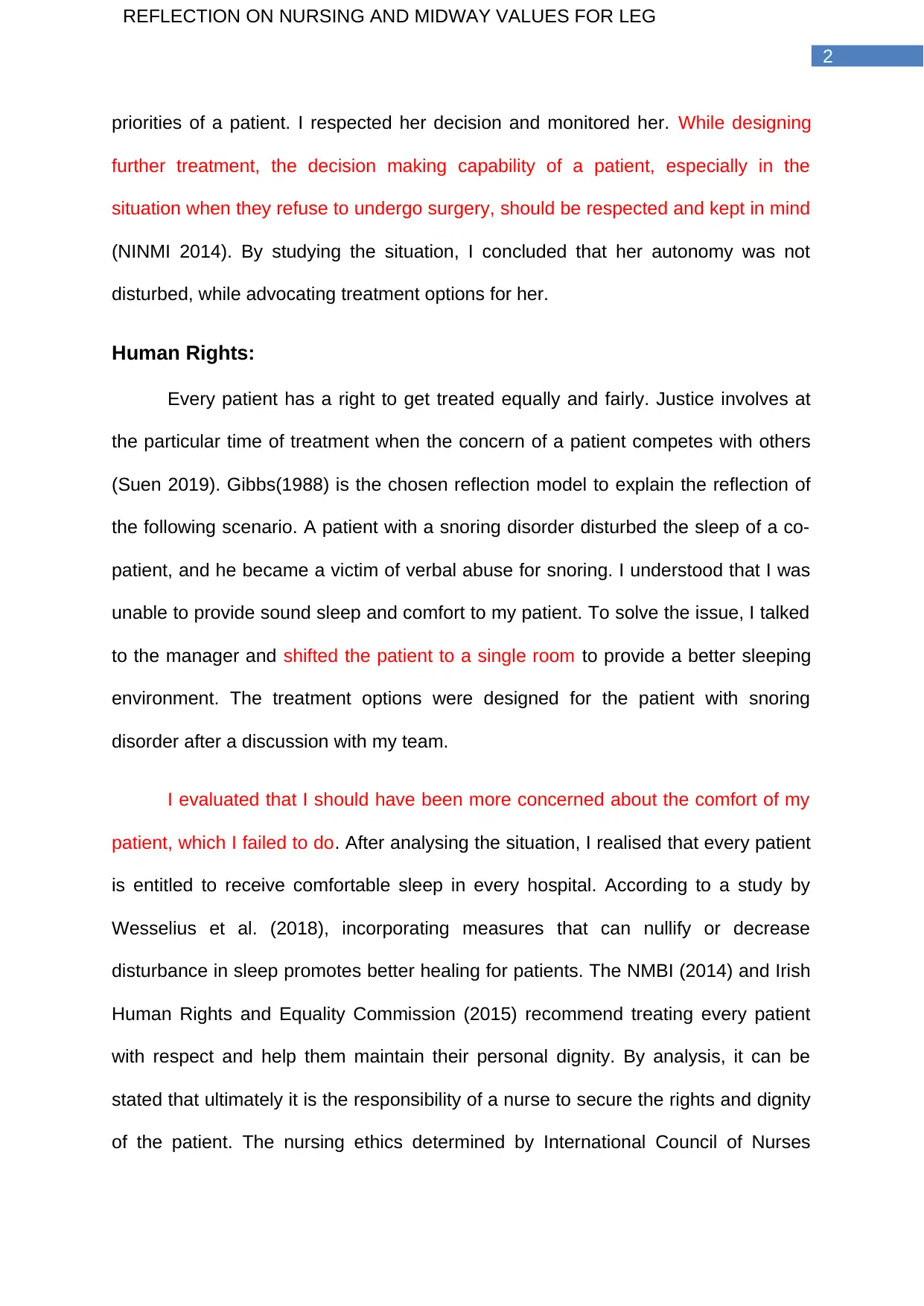
2
REFLECTION ON NURSING AND MIDWAY VALUES FOR LEG
priorities of a patient. I respected her decision and monitored her. While designing
further treatment, the decision making capability of a patient, especially in the
situation when they refuse to undergo surgery, should be respected and kept in mind
(NINMI 2014). By studying the situation, I concluded that her autonomy was not
disturbed, while advocating treatment options for her.
Human Rights:
Every patient has a right to get treated equally and fairly. Justice involves at
the particular time of treatment when the concern of a patient competes with others
(Suen 2019). Gibbs(1988) is the chosen reflection model to explain the reflection of
the following scenario. A patient with a snoring disorder disturbed the sleep of a co-
patient, and he became a victim of verbal abuse for snoring. I understood that I was
unable to provide sound sleep and comfort to my patient. To solve the issue, I talked
to the manager and shifted the patient to a single room to provide a better sleeping
environment. The treatment options were designed for the patient with snoring
disorder after a discussion with my team.
I evaluated that I should have been more concerned about the comfort of my
patient, which I failed to do. After analysing the situation, I realised that every patient
is entitled to receive comfortable sleep in every hospital. According to a study by
Wesselius et al. (2018), incorporating measures that can nullify or decrease
disturbance in sleep promotes better healing for patients. The NMBI (2014) and Irish
Human Rights and Equality Commission (2015) recommend treating every patient
with respect and help them maintain their personal dignity. By analysis, it can be
stated that ultimately it is the responsibility of a nurse to secure the rights and dignity
of the patient. The nursing ethics determined by International Council of Nurses
REFLECTION ON NURSING AND MIDWAY VALUES FOR LEG
priorities of a patient. I respected her decision and monitored her. While designing
further treatment, the decision making capability of a patient, especially in the
situation when they refuse to undergo surgery, should be respected and kept in mind
(NINMI 2014). By studying the situation, I concluded that her autonomy was not
disturbed, while advocating treatment options for her.
Human Rights:
Every patient has a right to get treated equally and fairly. Justice involves at
the particular time of treatment when the concern of a patient competes with others
(Suen 2019). Gibbs(1988) is the chosen reflection model to explain the reflection of
the following scenario. A patient with a snoring disorder disturbed the sleep of a co-
patient, and he became a victim of verbal abuse for snoring. I understood that I was
unable to provide sound sleep and comfort to my patient. To solve the issue, I talked
to the manager and shifted the patient to a single room to provide a better sleeping
environment. The treatment options were designed for the patient with snoring
disorder after a discussion with my team.
I evaluated that I should have been more concerned about the comfort of my
patient, which I failed to do. After analysing the situation, I realised that every patient
is entitled to receive comfortable sleep in every hospital. According to a study by
Wesselius et al. (2018), incorporating measures that can nullify or decrease
disturbance in sleep promotes better healing for patients. The NMBI (2014) and Irish
Human Rights and Equality Commission (2015) recommend treating every patient
with respect and help them maintain their personal dignity. By analysis, it can be
stated that ultimately it is the responsibility of a nurse to secure the rights and dignity
of the patient. The nursing ethics determined by International Council of Nurses
⊘ This is a preview!⊘
Do you want full access?
Subscribe today to unlock all pages.

Trusted by 1+ million students worldwide
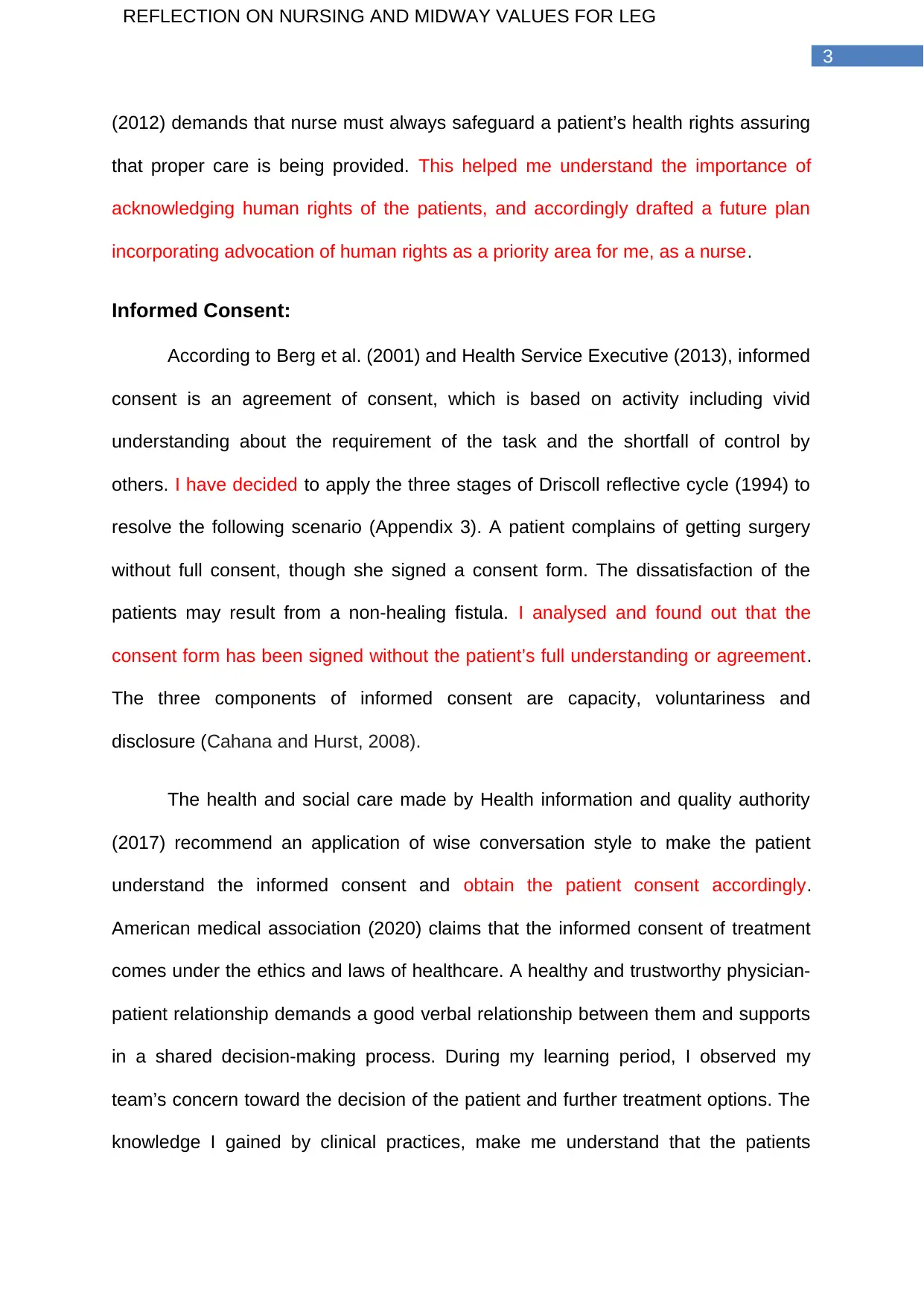
3
REFLECTION ON NURSING AND MIDWAY VALUES FOR LEG
(2012) demands that nurse must always safeguard a patient’s health rights assuring
that proper care is being provided. This helped me understand the importance of
acknowledging human rights of the patients, and accordingly drafted a future plan
incorporating advocation of human rights as a priority area for me, as a nurse.
Informed Consent:
According to Berg et al. (2001) and Health Service Executive (2013), informed
consent is an agreement of consent, which is based on activity including vivid
understanding about the requirement of the task and the shortfall of control by
others. I have decided to apply the three stages of Driscoll reflective cycle (1994) to
resolve the following scenario (Appendix 3). A patient complains of getting surgery
without full consent, though she signed a consent form. The dissatisfaction of the
patients may result from a non-healing fistula. I analysed and found out that the
consent form has been signed without the patient’s full understanding or agreement.
The three components of informed consent are capacity, voluntariness and
disclosure (Cahana and Hurst, 2008).
The health and social care made by Health information and quality authority
(2017) recommend an application of wise conversation style to make the patient
understand the informed consent and obtain the patient consent accordingly.
American medical association (2020) claims that the informed consent of treatment
comes under the ethics and laws of healthcare. A healthy and trustworthy physician-
patient relationship demands a good verbal relationship between them and supports
in a shared decision-making process. During my learning period, I observed my
team’s concern toward the decision of the patient and further treatment options. The
knowledge I gained by clinical practices, make me understand that the patients
REFLECTION ON NURSING AND MIDWAY VALUES FOR LEG
(2012) demands that nurse must always safeguard a patient’s health rights assuring
that proper care is being provided. This helped me understand the importance of
acknowledging human rights of the patients, and accordingly drafted a future plan
incorporating advocation of human rights as a priority area for me, as a nurse.
Informed Consent:
According to Berg et al. (2001) and Health Service Executive (2013), informed
consent is an agreement of consent, which is based on activity including vivid
understanding about the requirement of the task and the shortfall of control by
others. I have decided to apply the three stages of Driscoll reflective cycle (1994) to
resolve the following scenario (Appendix 3). A patient complains of getting surgery
without full consent, though she signed a consent form. The dissatisfaction of the
patients may result from a non-healing fistula. I analysed and found out that the
consent form has been signed without the patient’s full understanding or agreement.
The three components of informed consent are capacity, voluntariness and
disclosure (Cahana and Hurst, 2008).
The health and social care made by Health information and quality authority
(2017) recommend an application of wise conversation style to make the patient
understand the informed consent and obtain the patient consent accordingly.
American medical association (2020) claims that the informed consent of treatment
comes under the ethics and laws of healthcare. A healthy and trustworthy physician-
patient relationship demands a good verbal relationship between them and supports
in a shared decision-making process. During my learning period, I observed my
team’s concern toward the decision of the patient and further treatment options. The
knowledge I gained by clinical practices, make me understand that the patients
Paraphrase This Document
Need a fresh take? Get an instant paraphrase of this document with our AI Paraphraser
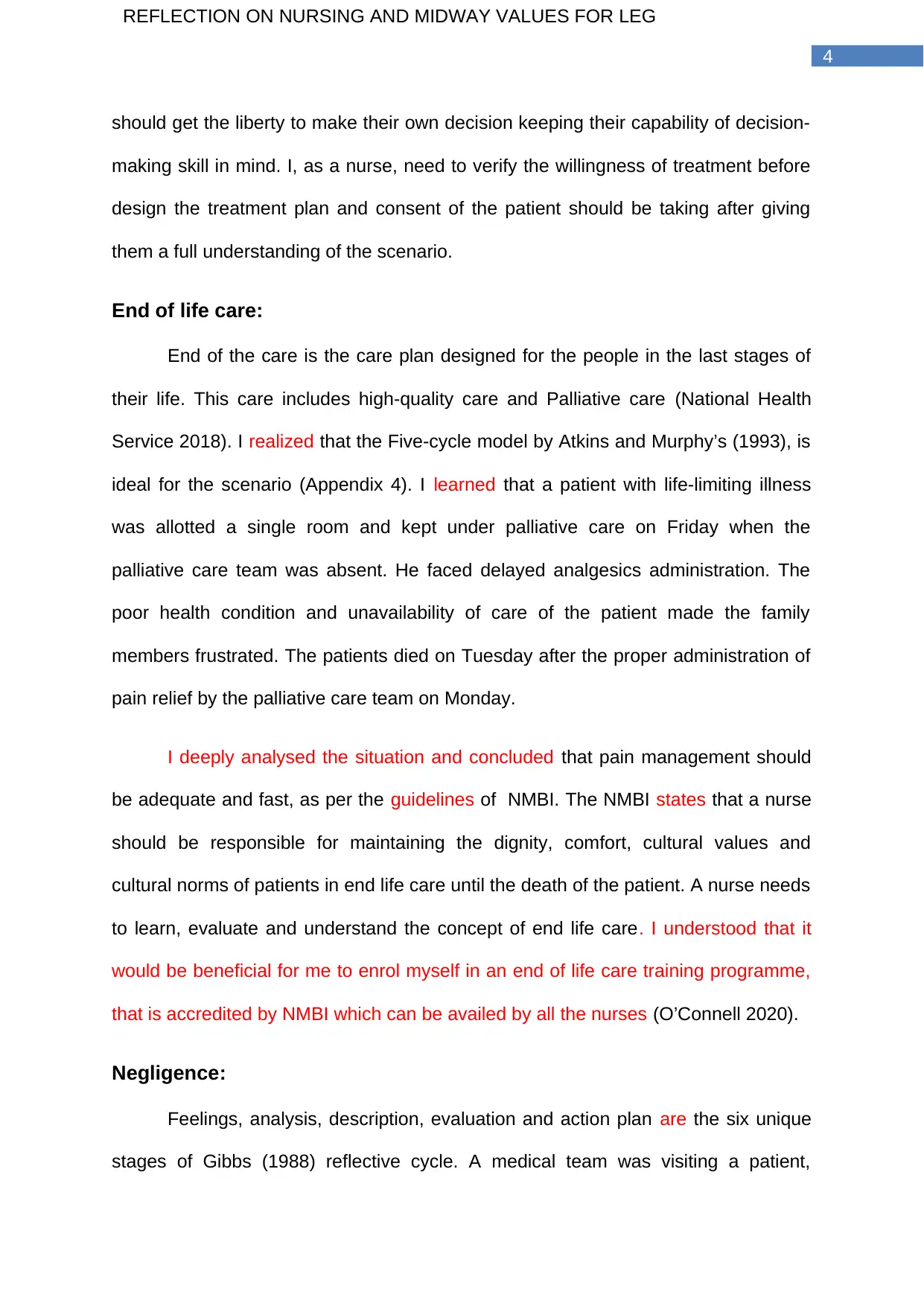
4
REFLECTION ON NURSING AND MIDWAY VALUES FOR LEG
should get the liberty to make their own decision keeping their capability of decision-
making skill in mind. I, as a nurse, need to verify the willingness of treatment before
design the treatment plan and consent of the patient should be taking after giving
them a full understanding of the scenario.
End of life care:
End of the care is the care plan designed for the people in the last stages of
their life. This care includes high-quality care and Palliative care (National Health
Service 2018). I realized that the Five-cycle model by Atkins and Murphy’s (1993), is
ideal for the scenario (Appendix 4). I learned that a patient with life-limiting illness
was allotted a single room and kept under palliative care on Friday when the
palliative care team was absent. He faced delayed analgesics administration. The
poor health condition and unavailability of care of the patient made the family
members frustrated. The patients died on Tuesday after the proper administration of
pain relief by the palliative care team on Monday.
I deeply analysed the situation and concluded that pain management should
be adequate and fast, as per the guidelines of NMBI. The NMBI states that a nurse
should be responsible for maintaining the dignity, comfort, cultural values and
cultural norms of patients in end life care until the death of the patient. A nurse needs
to learn, evaluate and understand the concept of end life care. I understood that it
would be beneficial for me to enrol myself in an end of life care training programme,
that is accredited by NMBI which can be availed by all the nurses (O’Connell 2020).
Negligence:
Feelings, analysis, description, evaluation and action plan are the six unique
stages of Gibbs (1988) reflective cycle. A medical team was visiting a patient,
REFLECTION ON NURSING AND MIDWAY VALUES FOR LEG
should get the liberty to make their own decision keeping their capability of decision-
making skill in mind. I, as a nurse, need to verify the willingness of treatment before
design the treatment plan and consent of the patient should be taking after giving
them a full understanding of the scenario.
End of life care:
End of the care is the care plan designed for the people in the last stages of
their life. This care includes high-quality care and Palliative care (National Health
Service 2018). I realized that the Five-cycle model by Atkins and Murphy’s (1993), is
ideal for the scenario (Appendix 4). I learned that a patient with life-limiting illness
was allotted a single room and kept under palliative care on Friday when the
palliative care team was absent. He faced delayed analgesics administration. The
poor health condition and unavailability of care of the patient made the family
members frustrated. The patients died on Tuesday after the proper administration of
pain relief by the palliative care team on Monday.
I deeply analysed the situation and concluded that pain management should
be adequate and fast, as per the guidelines of NMBI. The NMBI states that a nurse
should be responsible for maintaining the dignity, comfort, cultural values and
cultural norms of patients in end life care until the death of the patient. A nurse needs
to learn, evaluate and understand the concept of end life care. I understood that it
would be beneficial for me to enrol myself in an end of life care training programme,
that is accredited by NMBI which can be availed by all the nurses (O’Connell 2020).
Negligence:
Feelings, analysis, description, evaluation and action plan are the six unique
stages of Gibbs (1988) reflective cycle. A medical team was visiting a patient,
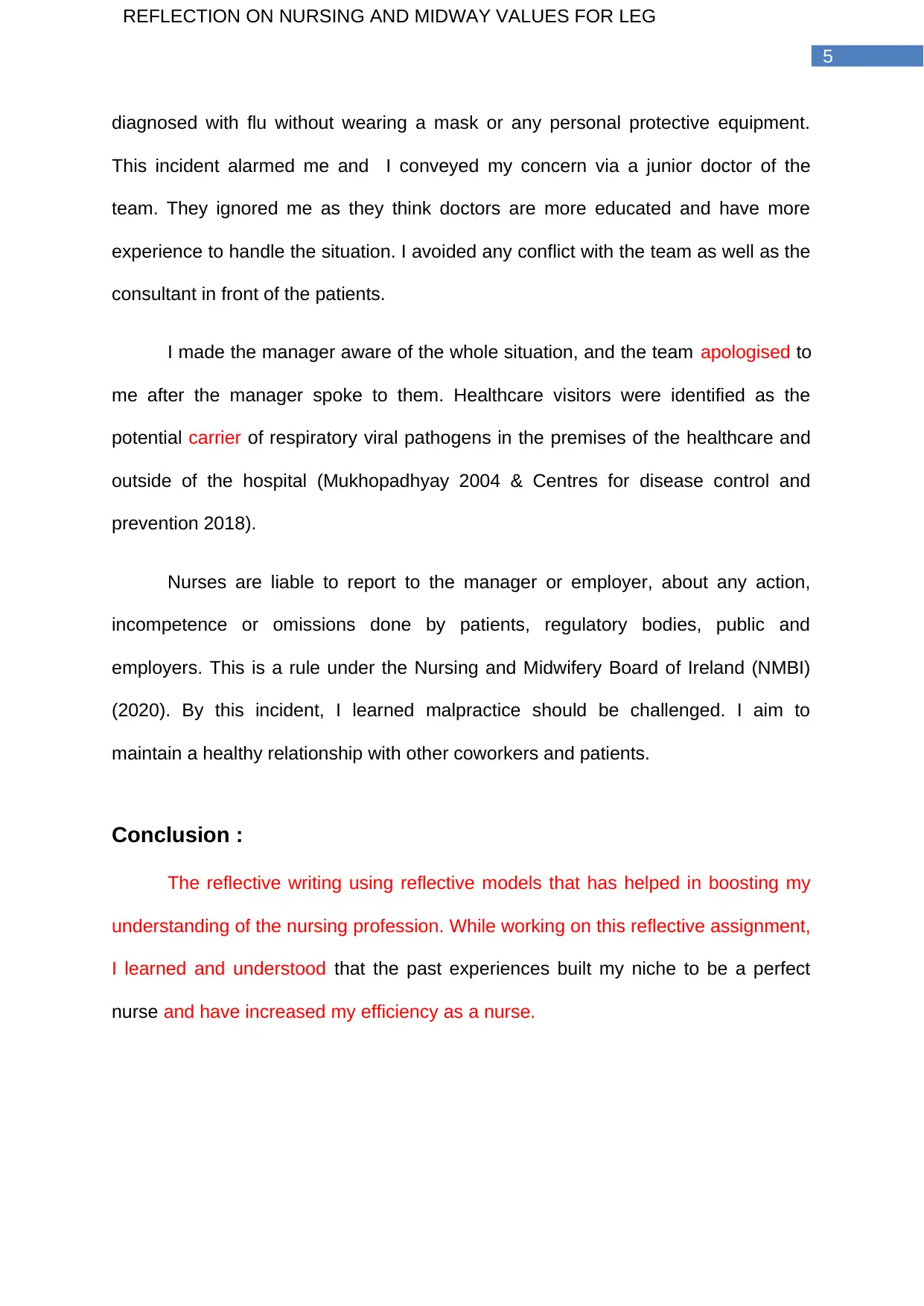
5
REFLECTION ON NURSING AND MIDWAY VALUES FOR LEG
diagnosed with flu without wearing a mask or any personal protective equipment.
This incident alarmed me and I conveyed my concern via a junior doctor of the
team. They ignored me as they think doctors are more educated and have more
experience to handle the situation. I avoided any conflict with the team as well as the
consultant in front of the patients.
I made the manager aware of the whole situation, and the team apologised to
me after the manager spoke to them. Healthcare visitors were identified as the
potential carrier of respiratory viral pathogens in the premises of the healthcare and
outside of the hospital (Mukhopadhyay 2004 & Centres for disease control and
prevention 2018).
Nurses are liable to report to the manager or employer, about any action,
incompetence or omissions done by patients, regulatory bodies, public and
employers. This is a rule under the Nursing and Midwifery Board of Ireland (NMBI)
(2020). By this incident, I learned malpractice should be challenged. I aim to
maintain a healthy relationship with other coworkers and patients.
Conclusion :
The reflective writing using reflective models that has helped in boosting my
understanding of the nursing profession. While working on this reflective assignment,
I learned and understood that the past experiences built my niche to be a perfect
nurse and have increased my efficiency as a nurse.
REFLECTION ON NURSING AND MIDWAY VALUES FOR LEG
diagnosed with flu without wearing a mask or any personal protective equipment.
This incident alarmed me and I conveyed my concern via a junior doctor of the
team. They ignored me as they think doctors are more educated and have more
experience to handle the situation. I avoided any conflict with the team as well as the
consultant in front of the patients.
I made the manager aware of the whole situation, and the team apologised to
me after the manager spoke to them. Healthcare visitors were identified as the
potential carrier of respiratory viral pathogens in the premises of the healthcare and
outside of the hospital (Mukhopadhyay 2004 & Centres for disease control and
prevention 2018).
Nurses are liable to report to the manager or employer, about any action,
incompetence or omissions done by patients, regulatory bodies, public and
employers. This is a rule under the Nursing and Midwifery Board of Ireland (NMBI)
(2020). By this incident, I learned malpractice should be challenged. I aim to
maintain a healthy relationship with other coworkers and patients.
Conclusion :
The reflective writing using reflective models that has helped in boosting my
understanding of the nursing profession. While working on this reflective assignment,
I learned and understood that the past experiences built my niche to be a perfect
nurse and have increased my efficiency as a nurse.
⊘ This is a preview!⊘
Do you want full access?
Subscribe today to unlock all pages.

Trusted by 1+ million students worldwide
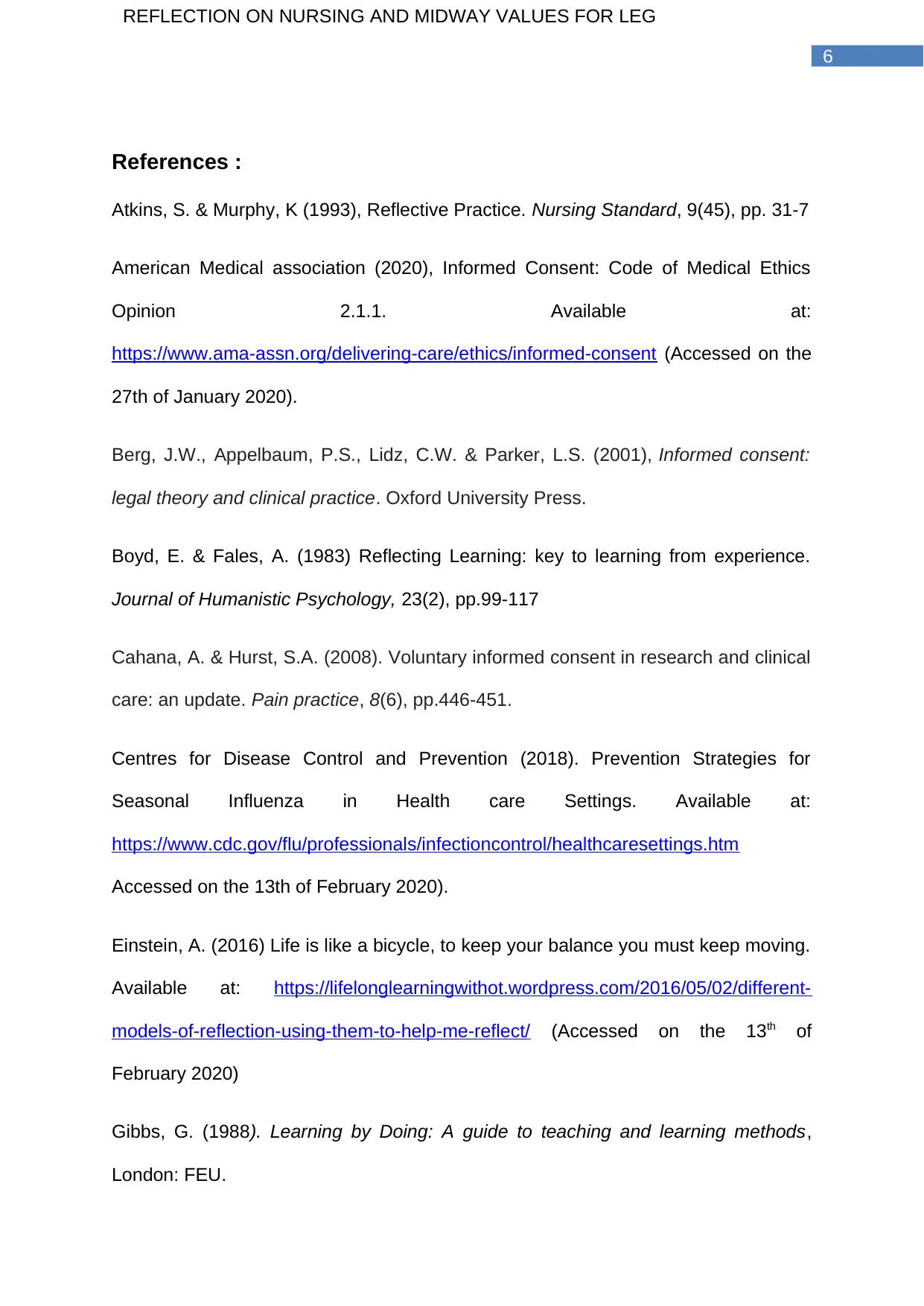
6
REFLECTION ON NURSING AND MIDWAY VALUES FOR LEG
References :
Atkins, S. & Murphy, K (1993), Reflective Practice. Nursing Standard, 9(45), pp. 31-7
American Medical association (2020), Informed Consent: Code of Medical Ethics
Opinion 2.1.1. Available at:
https://www.ama-assn.org/delivering-care/ethics/informed-consent (Accessed on the
27th of January 2020).
Berg, J.W., Appelbaum, P.S., Lidz, C.W. & Parker, L.S. (2001), Informed consent:
legal theory and clinical practice. Oxford University Press.
Boyd, E. & Fales, A. (1983) Reflecting Learning: key to learning from experience.
Journal of Humanistic Psychology, 23(2), pp.99-117
Cahana, A. & Hurst, S.A. (2008). Voluntary informed consent in research and clinical
care: an update. Pain practice, 8(6), pp.446-451.
Centres for Disease Control and Prevention (2018). Prevention Strategies for
Seasonal Influenza in Health care Settings. Available at:
https://www.cdc.gov/flu/professionals/infectioncontrol/healthcaresettings.htm
Accessed on the 13th of February 2020).
Einstein, A. (2016) Life is like a bicycle, to keep your balance you must keep moving.
Available at: https://lifelonglearningwithot.wordpress.com/2016/05/02/different-
models-of-reflection-using-them-to-help-me-reflect/ (Accessed on the 13th of
February 2020)
Gibbs, G. (1988). Learning by Doing: A guide to teaching and learning methods,
London: FEU.
REFLECTION ON NURSING AND MIDWAY VALUES FOR LEG
References :
Atkins, S. & Murphy, K (1993), Reflective Practice. Nursing Standard, 9(45), pp. 31-7
American Medical association (2020), Informed Consent: Code of Medical Ethics
Opinion 2.1.1. Available at:
https://www.ama-assn.org/delivering-care/ethics/informed-consent (Accessed on the
27th of January 2020).
Berg, J.W., Appelbaum, P.S., Lidz, C.W. & Parker, L.S. (2001), Informed consent:
legal theory and clinical practice. Oxford University Press.
Boyd, E. & Fales, A. (1983) Reflecting Learning: key to learning from experience.
Journal of Humanistic Psychology, 23(2), pp.99-117
Cahana, A. & Hurst, S.A. (2008). Voluntary informed consent in research and clinical
care: an update. Pain practice, 8(6), pp.446-451.
Centres for Disease Control and Prevention (2018). Prevention Strategies for
Seasonal Influenza in Health care Settings. Available at:
https://www.cdc.gov/flu/professionals/infectioncontrol/healthcaresettings.htm
Accessed on the 13th of February 2020).
Einstein, A. (2016) Life is like a bicycle, to keep your balance you must keep moving.
Available at: https://lifelonglearningwithot.wordpress.com/2016/05/02/different-
models-of-reflection-using-them-to-help-me-reflect/ (Accessed on the 13th of
February 2020)
Gibbs, G. (1988). Learning by Doing: A guide to teaching and learning methods,
London: FEU.
Paraphrase This Document
Need a fresh take? Get an instant paraphrase of this document with our AI Paraphraser
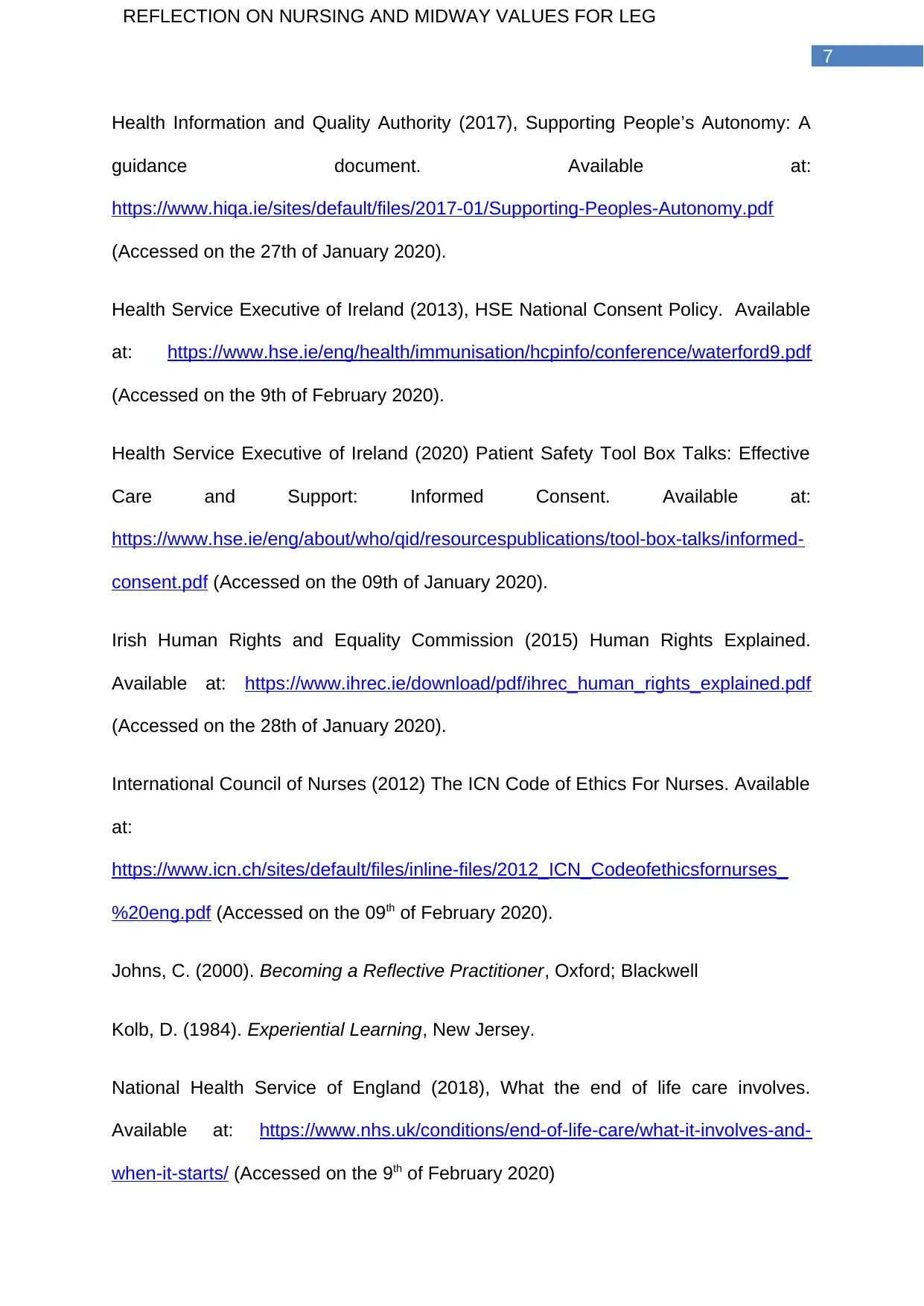
7
REFLECTION ON NURSING AND MIDWAY VALUES FOR LEG
Health Information and Quality Authority (2017), Supporting People’s Autonomy: A
guidance document. Available at:
https://www.hiqa.ie/sites/default/files/2017-01/Supporting-Peoples-Autonomy.pdf
(Accessed on the 27th of January 2020).
Health Service Executive of Ireland (2013), HSE National Consent Policy. Available
at: https://www.hse.ie/eng/health/immunisation/hcpinfo/conference/waterford9.pdf
(Accessed on the 9th of February 2020).
Health Service Executive of Ireland (2020) Patient Safety Tool Box Talks: Effective
Care and Support: Informed Consent. Available at:
https://www.hse.ie/eng/about/who/qid/resourcespublications/tool-box-talks/informed-
consent.pdf (Accessed on the 09th of January 2020).
Irish Human Rights and Equality Commission (2015) Human Rights Explained.
Available at: https://www.ihrec.ie/download/pdf/ihrec_human_rights_explained.pdf
(Accessed on the 28th of January 2020).
International Council of Nurses (2012) The ICN Code of Ethics For Nurses. Available
at:
https://www.icn.ch/sites/default/files/inline-files/2012_ICN_Codeofethicsfornurses_
%20eng.pdf (Accessed on the 09th of February 2020).
Johns, C. (2000). Becoming a Reflective Practitioner, Oxford; Blackwell
Kolb, D. (1984). Experiential Learning, New Jersey.
National Health Service of England (2018), What the end of life care involves.
Available at: https://www.nhs.uk/conditions/end-of-life-care/what-it-involves-and-
when-it-starts/ (Accessed on the 9th of February 2020)
REFLECTION ON NURSING AND MIDWAY VALUES FOR LEG
Health Information and Quality Authority (2017), Supporting People’s Autonomy: A
guidance document. Available at:
https://www.hiqa.ie/sites/default/files/2017-01/Supporting-Peoples-Autonomy.pdf
(Accessed on the 27th of January 2020).
Health Service Executive of Ireland (2013), HSE National Consent Policy. Available
at: https://www.hse.ie/eng/health/immunisation/hcpinfo/conference/waterford9.pdf
(Accessed on the 9th of February 2020).
Health Service Executive of Ireland (2020) Patient Safety Tool Box Talks: Effective
Care and Support: Informed Consent. Available at:
https://www.hse.ie/eng/about/who/qid/resourcespublications/tool-box-talks/informed-
consent.pdf (Accessed on the 09th of January 2020).
Irish Human Rights and Equality Commission (2015) Human Rights Explained.
Available at: https://www.ihrec.ie/download/pdf/ihrec_human_rights_explained.pdf
(Accessed on the 28th of January 2020).
International Council of Nurses (2012) The ICN Code of Ethics For Nurses. Available
at:
https://www.icn.ch/sites/default/files/inline-files/2012_ICN_Codeofethicsfornurses_
%20eng.pdf (Accessed on the 09th of February 2020).
Johns, C. (2000). Becoming a Reflective Practitioner, Oxford; Blackwell
Kolb, D. (1984). Experiential Learning, New Jersey.
National Health Service of England (2018), What the end of life care involves.
Available at: https://www.nhs.uk/conditions/end-of-life-care/what-it-involves-and-
when-it-starts/ (Accessed on the 9th of February 2020)
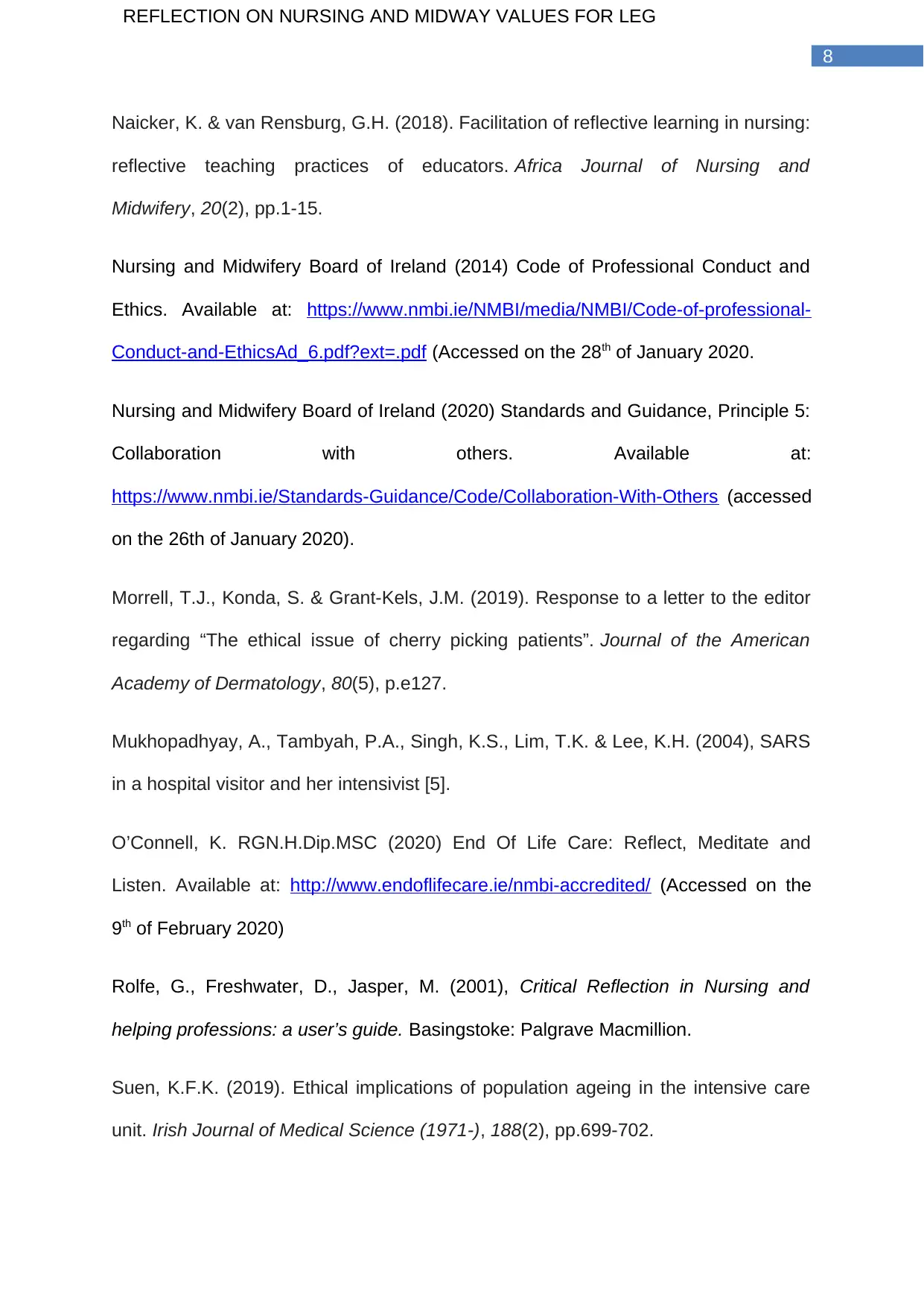
8
REFLECTION ON NURSING AND MIDWAY VALUES FOR LEG
Naicker, K. & van Rensburg, G.H. (2018). Facilitation of reflective learning in nursing:
reflective teaching practices of educators. Africa Journal of Nursing and
Midwifery, 20(2), pp.1-15.
Nursing and Midwifery Board of Ireland (2014) Code of Professional Conduct and
Ethics. Available at: https://www.nmbi.ie/NMBI/media/NMBI/Code-of-professional-
Conduct-and-EthicsAd_6.pdf?ext=.pdf (Accessed on the 28th of January 2020.
Nursing and Midwifery Board of Ireland (2020) Standards and Guidance, Principle 5:
Collaboration with others. Available at:
https://www.nmbi.ie/Standards-Guidance/Code/Collaboration-With-Others (accessed
on the 26th of January 2020).
Morrell, T.J., Konda, S. & Grant-Kels, J.M. (2019). Response to a letter to the editor
regarding “The ethical issue of cherry picking patients”. Journal of the American
Academy of Dermatology, 80(5), p.e127.
Mukhopadhyay, A., Tambyah, P.A., Singh, K.S., Lim, T.K. & Lee, K.H. (2004), SARS
in a hospital visitor and her intensivist [5].
O’Connell, K. RGN.H.Dip.MSC (2020) End Of Life Care: Reflect, Meditate and
Listen. Available at: http://www.endoflifecare.ie/nmbi-accredited/ (Accessed on the
9th of February 2020)
Rolfe, G., Freshwater, D., Jasper, M. (2001), Critical Reflection in Nursing and
helping professions: a user’s guide. Basingstoke: Palgrave Macmillion.
Suen, K.F.K. (2019). Ethical implications of population ageing in the intensive care
unit. Irish Journal of Medical Science (1971-), 188(2), pp.699-702.
REFLECTION ON NURSING AND MIDWAY VALUES FOR LEG
Naicker, K. & van Rensburg, G.H. (2018). Facilitation of reflective learning in nursing:
reflective teaching practices of educators. Africa Journal of Nursing and
Midwifery, 20(2), pp.1-15.
Nursing and Midwifery Board of Ireland (2014) Code of Professional Conduct and
Ethics. Available at: https://www.nmbi.ie/NMBI/media/NMBI/Code-of-professional-
Conduct-and-EthicsAd_6.pdf?ext=.pdf (Accessed on the 28th of January 2020.
Nursing and Midwifery Board of Ireland (2020) Standards and Guidance, Principle 5:
Collaboration with others. Available at:
https://www.nmbi.ie/Standards-Guidance/Code/Collaboration-With-Others (accessed
on the 26th of January 2020).
Morrell, T.J., Konda, S. & Grant-Kels, J.M. (2019). Response to a letter to the editor
regarding “The ethical issue of cherry picking patients”. Journal of the American
Academy of Dermatology, 80(5), p.e127.
Mukhopadhyay, A., Tambyah, P.A., Singh, K.S., Lim, T.K. & Lee, K.H. (2004), SARS
in a hospital visitor and her intensivist [5].
O’Connell, K. RGN.H.Dip.MSC (2020) End Of Life Care: Reflect, Meditate and
Listen. Available at: http://www.endoflifecare.ie/nmbi-accredited/ (Accessed on the
9th of February 2020)
Rolfe, G., Freshwater, D., Jasper, M. (2001), Critical Reflection in Nursing and
helping professions: a user’s guide. Basingstoke: Palgrave Macmillion.
Suen, K.F.K. (2019). Ethical implications of population ageing in the intensive care
unit. Irish Journal of Medical Science (1971-), 188(2), pp.699-702.
⊘ This is a preview!⊘
Do you want full access?
Subscribe today to unlock all pages.

Trusted by 1+ million students worldwide
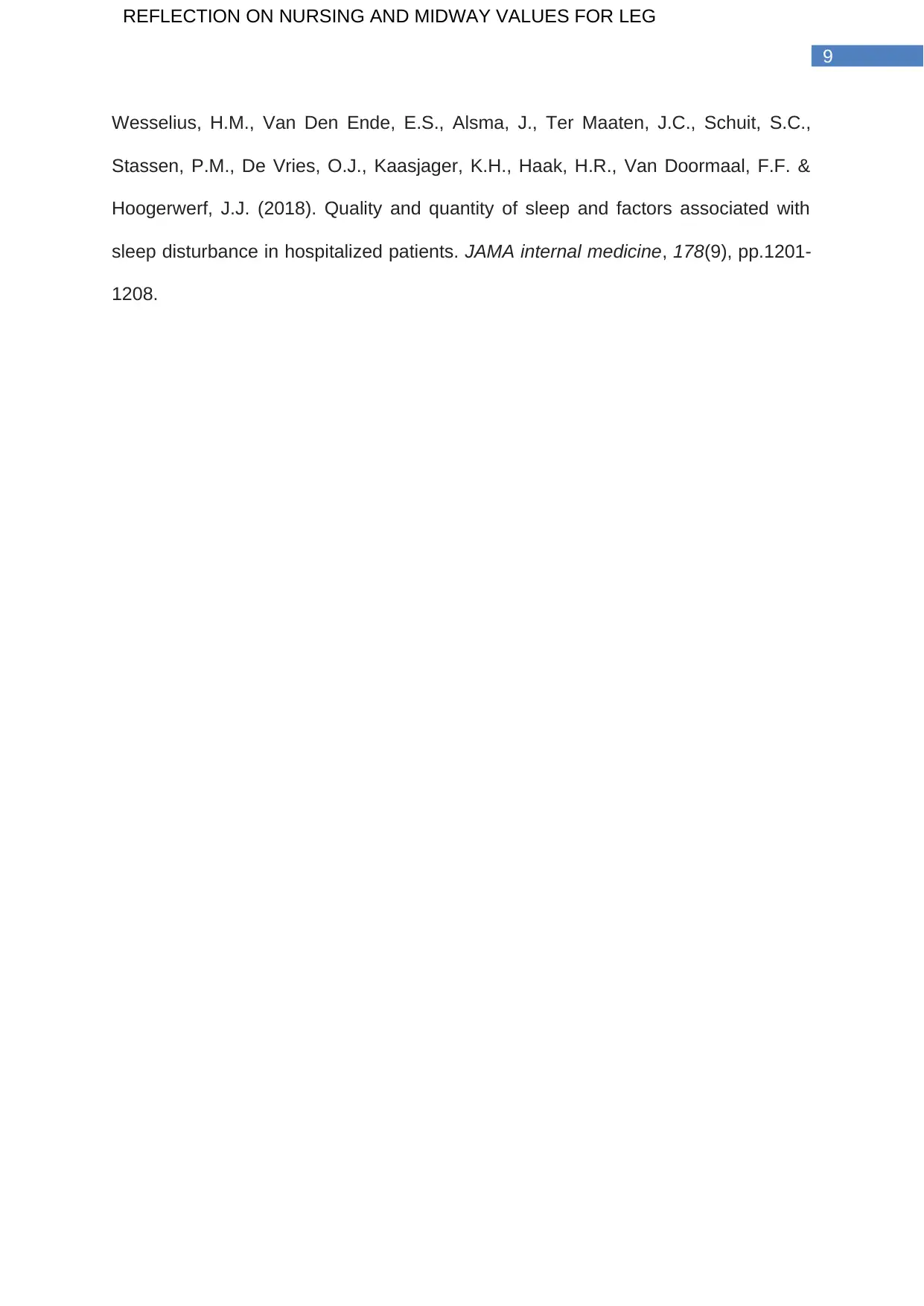
9
REFLECTION ON NURSING AND MIDWAY VALUES FOR LEG
Wesselius, H.M., Van Den Ende, E.S., Alsma, J., Ter Maaten, J.C., Schuit, S.C.,
Stassen, P.M., De Vries, O.J., Kaasjager, K.H., Haak, H.R., Van Doormaal, F.F. &
Hoogerwerf, J.J. (2018). Quality and quantity of sleep and factors associated with
sleep disturbance in hospitalized patients. JAMA internal medicine, 178(9), pp.1201-
1208.
REFLECTION ON NURSING AND MIDWAY VALUES FOR LEG
Wesselius, H.M., Van Den Ende, E.S., Alsma, J., Ter Maaten, J.C., Schuit, S.C.,
Stassen, P.M., De Vries, O.J., Kaasjager, K.H., Haak, H.R., Van Doormaal, F.F. &
Hoogerwerf, J.J. (2018). Quality and quantity of sleep and factors associated with
sleep disturbance in hospitalized patients. JAMA internal medicine, 178(9), pp.1201-
1208.
Paraphrase This Document
Need a fresh take? Get an instant paraphrase of this document with our AI Paraphraser
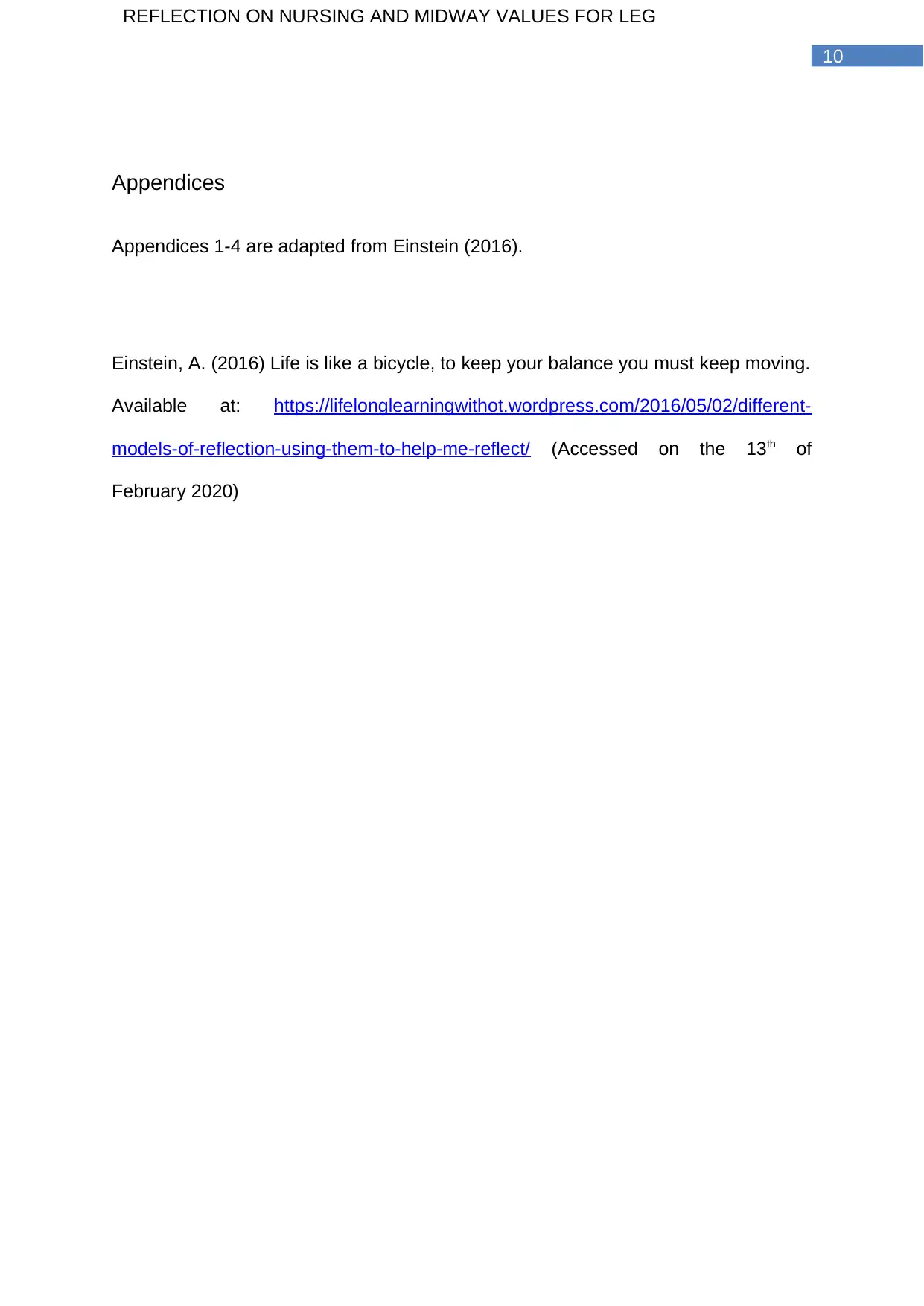
10
REFLECTION ON NURSING AND MIDWAY VALUES FOR LEG
Appendices
Appendices 1-4 are adapted from Einstein (2016).
Einstein, A. (2016) Life is like a bicycle, to keep your balance you must keep moving.
Available at: https://lifelonglearningwithot.wordpress.com/2016/05/02/different-
models-of-reflection-using-them-to-help-me-reflect/ (Accessed on the 13th of
February 2020)
REFLECTION ON NURSING AND MIDWAY VALUES FOR LEG
Appendices
Appendices 1-4 are adapted from Einstein (2016).
Einstein, A. (2016) Life is like a bicycle, to keep your balance you must keep moving.
Available at: https://lifelonglearningwithot.wordpress.com/2016/05/02/different-
models-of-reflection-using-them-to-help-me-reflect/ (Accessed on the 13th of
February 2020)
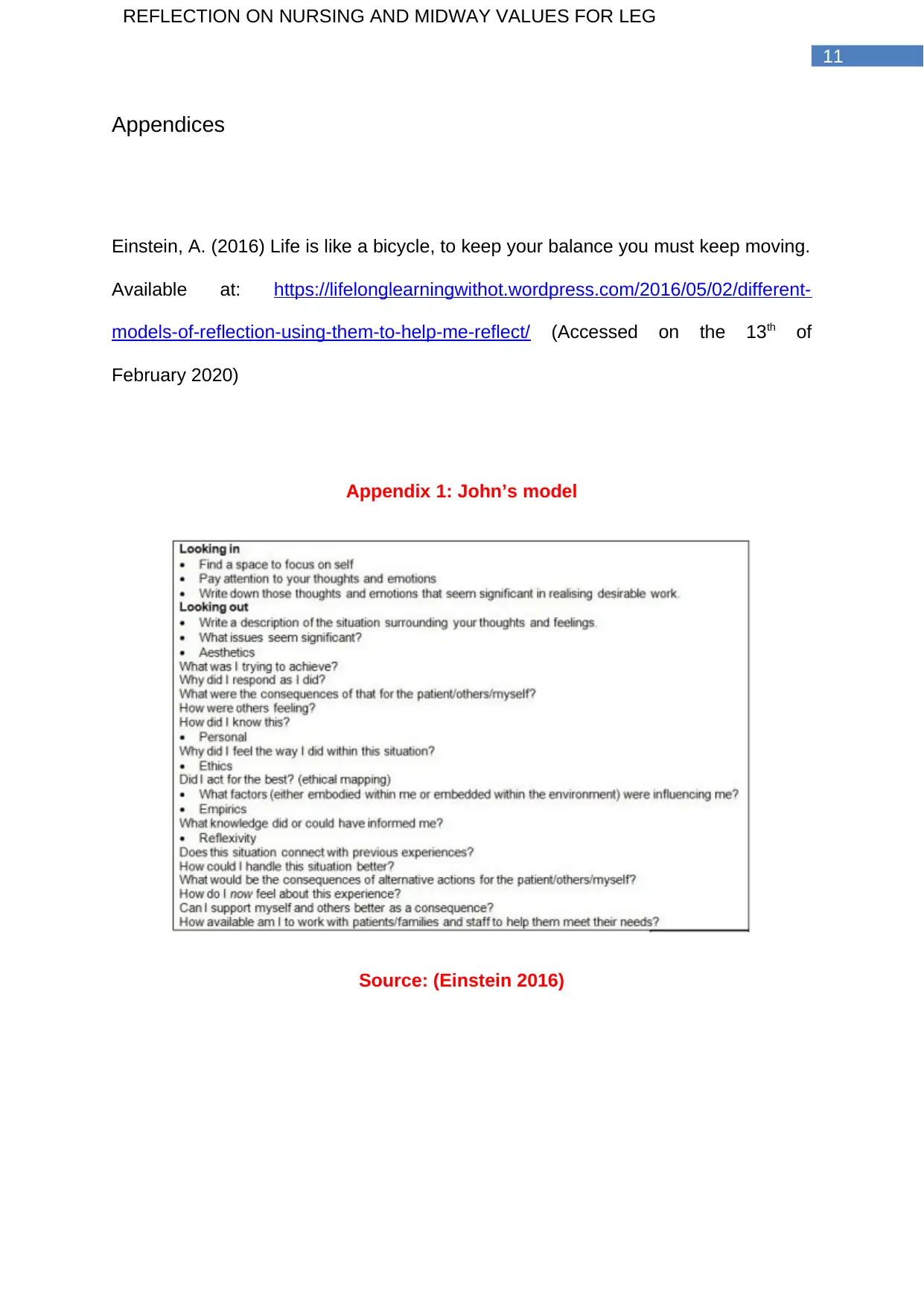
11
REFLECTION ON NURSING AND MIDWAY VALUES FOR LEG
Appendices
Einstein, A. (2016) Life is like a bicycle, to keep your balance you must keep moving.
Available at: https://lifelonglearningwithot.wordpress.com/2016/05/02/different-
models-of-reflection-using-them-to-help-me-reflect/ (Accessed on the 13th of
February 2020)
Appendix 1: John’s model
Source: (Einstein 2016)
REFLECTION ON NURSING AND MIDWAY VALUES FOR LEG
Appendices
Einstein, A. (2016) Life is like a bicycle, to keep your balance you must keep moving.
Available at: https://lifelonglearningwithot.wordpress.com/2016/05/02/different-
models-of-reflection-using-them-to-help-me-reflect/ (Accessed on the 13th of
February 2020)
Appendix 1: John’s model
Source: (Einstein 2016)
⊘ This is a preview!⊘
Do you want full access?
Subscribe today to unlock all pages.

Trusted by 1+ million students worldwide
1 out of 14
Related Documents
Your All-in-One AI-Powered Toolkit for Academic Success.
+13062052269
info@desklib.com
Available 24*7 on WhatsApp / Email
![[object Object]](/_next/static/media/star-bottom.7253800d.svg)
Unlock your academic potential
Copyright © 2020–2025 A2Z Services. All Rights Reserved. Developed and managed by ZUCOL.





